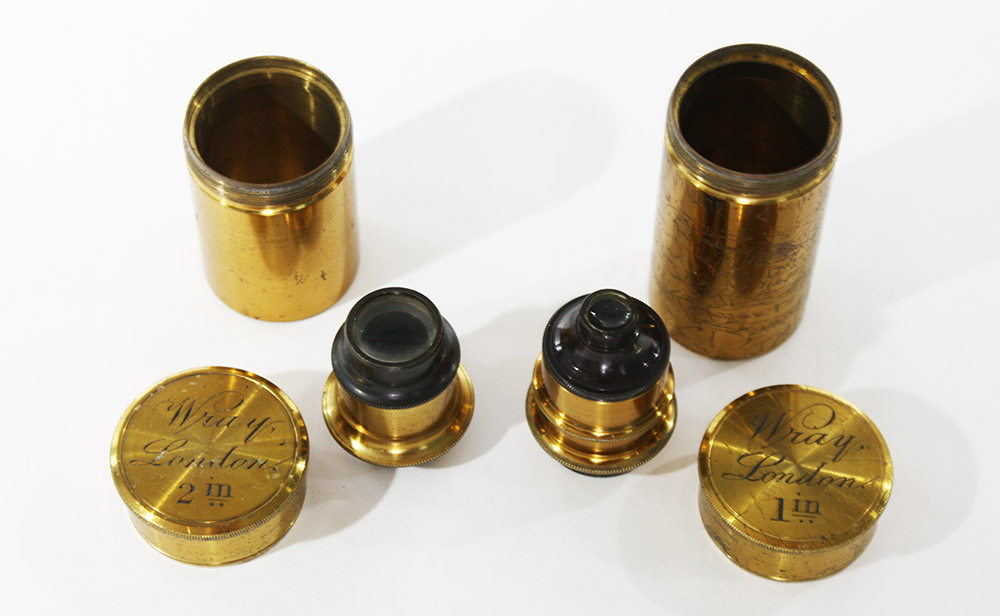
Figure 1. Two microscope objective lenses, 1 and 2 inch, produced by W. Wray ca. 1880-1900.
William Wray, 1829 - 1885
William James Wray, 1851 - 1907
Henry Wray, 1854 - 1902
Joseph Turnbull, 1840 - 1913
Eliza Turnbull Wray, ca. 1830 - 1906
by Brian Stevenson
last updated June, 2022
William Wray established a lens-making business in London during 1850. He initially produced lenses for telescopes, but soon branched into making objective lenses for microscopes. He was especially well known for preparing high-quality objectives of low and medium magnifications (Figure 1). Camera and projector lenses became major products by the end of the nineteenth century.
The Wray optical business was sold out of the family in 1908, and the firm then primarily produced binoculars.

Figure 1.
Two microscope objective lenses, 1 and 2 inch, produced by W. Wray ca. 1880-1900.
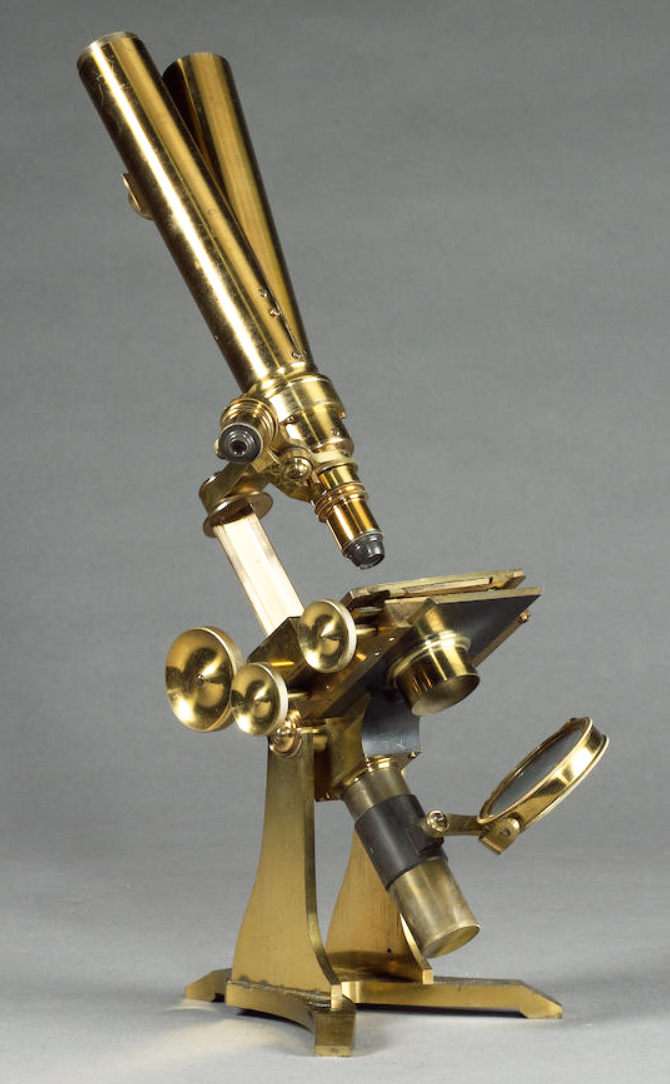
Figure 2.
A ca. 1870 binocular microscope, signed "W. Wray, Optician, London". As a manufacturer of lenses, with only a small number of employees, it is unlikely that Wray built the brasswork of such instruments in house, but instead probably purchased the body from an outside manufacturer. Image adapted for nonprofit, educational purposes from an internet auction site.
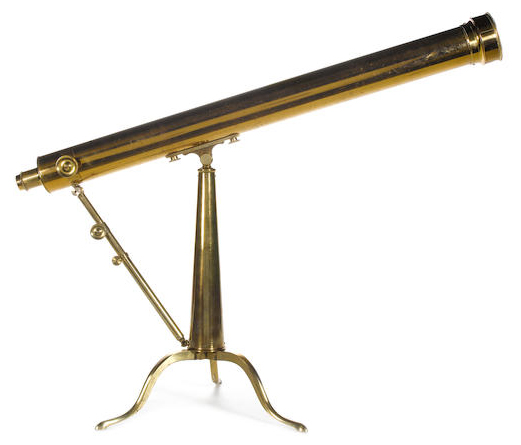
Figure 3.
A refracting telescope, with objective lens mount engraved "Wray London". While William Wray (or his successors) undoubtedly made the lenses of this telescope, but the brasswork was probably brought in from an outside manufacturer. Image adapted for nonprofit, educational purposes from an internet auction site.
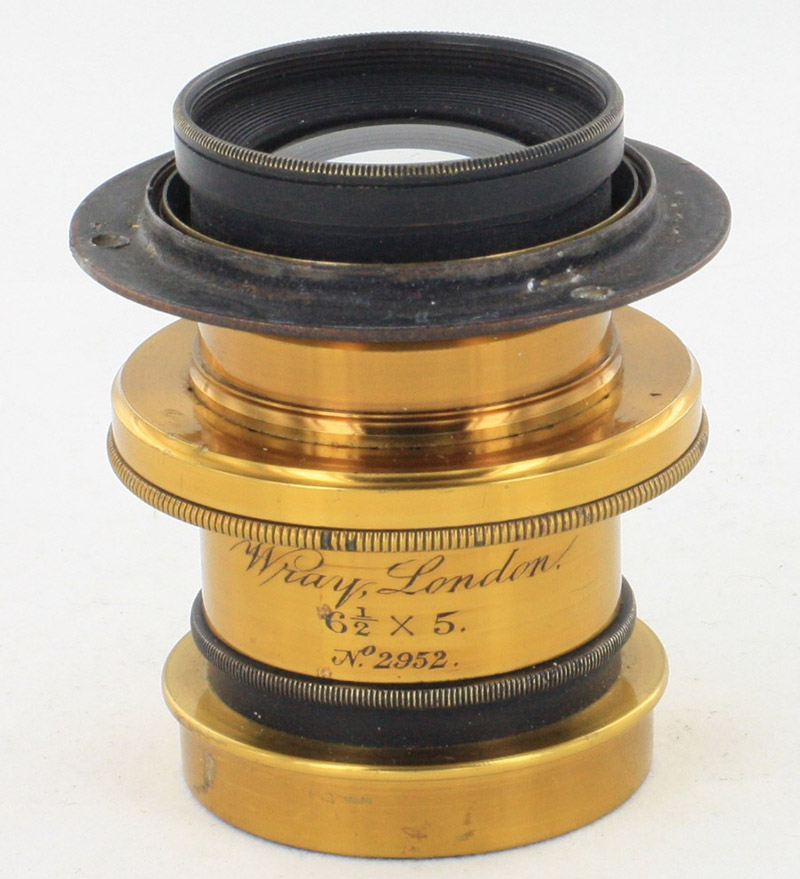
Figure 4.
A ca. 1900 camera lens from the Wray optical business. The firm retained the name "W. Wray" until it was sold out of the family in 1908. Image adapted for nonprofit, educational purposes from an internet auction site.
William Wray was born on December 6, 1829, in Whitby, Yorkshire. He was the eldest of three children of William and Hannah Wray, and the only boy. Father William was described on his son’s baptism record as being a “waterman”, and later records refer to his as a “master mariner”, implying that he was a sailor and, later, a ship’s captain.
Wray’s 1886 obituary from the Royal Astronomical Society stated, “His father, who was a sea-captain, wished to take him to sea, but his mother objecting, he was articled to a solicitor. He had a great love for astronomy and optics, and amused himself by constructing some reflecting telescopes... Not liking the legal profession, he came to London in the year 1850, and commenced the practice of an optician”. Wray’s optical business was largely, if not entirely, dedicated to lenses for telescopes, microscopes, and other apparatus.
The record of Wray’s November 3, 1850 marriage to Eliza Turnbull gives his occupation a “optician”. The June 6, 1841 census recorded the same occupation. Their first son, William James Wray, was born during April, 1851. Their second child, Henry, was born in early 1854. He was followed by at least five additional children. William Jr. and Henry later inherited the Wray optical business.
Several members of Eliza’s family also lived with the Wrays at various times. This included her brother, Joseph Turnbull, an “optician” who lived with the family from at least the 1860s onward and later became a partner in the Wray optical business.
For quite some time, Wray pursued optimization of an older approach toward eliminating chromatic aberration in magnifying lenses, which was to fill spaces between lenses with fluid or semi-solid substances rather than air. Theoretically, this made sense, rather like using immersion oil for high-power objective lenses. Practically, it was difficult to implement. The 1886 obituary further noted, “He spent much time in experiments for the reduction of the secondary spectrum, and succeeded in making object glasses practically free from outstanding colour; but these were unfortunately not permanent, owing to the fact that only fluids had the required dispersion, and in consequence of their contraction and expansion it was found to be quite impossible to retain them between the lenses for any great length of time.”
Nonetheless, Wray felt sufficiently confident in his optical devices to enter in the 1851 International Exposition. The jury was not impressed:
“Wray exhibits a seven-foot refracting telescope, 4 ½ inches aperture. The peculiarity of this telescope is the substitution of a solid substance instead of flint glass. On trial it was found to be badly achromatized. The colour above the image did not seem to be that usually called the secondary spectrum, but a remain of colour not fully compensated. The glass was neither fully corrected for sphericity nor for colour. It was observe that the object lens had rather a strong yellow tint, and was somewhat blotchy, as if the material used was not quite uniform in colour; all interior reflections were destroyed, so that it could not be suspected to be other than a single glass. As a telescope, it is not very good, but, though an imperfect trial, is yet a fair attempt to move out of the beaten track, and, as a step towards the possible revival of fluid or semifluid object-glasses, deserves commendation.”
In 1866, Wray obtained a patent for “improvements in achromatic object glasses” for use with microscopes and telescopes. This involved use of various oils or semi-solid substances between glass lenses. Wray wrote, “According to my Invention the irrationality existing between flint and crown glass is destroyed by the introduction of a third medium, as a thin meniscus lens, placed between the flint and crown glass lenses of the compound lens, the said meniscus lens being composed of certain substances or compounds herein-after mentioned, in all of which the irrationality with any given crown or flint glass is higher in proportion than their mean dispersion; the high irrationality of the meniscus lens is … opposed to the comparatively low irrationality of the crown and flint lenses in the method employed in my Invention. All the substances used for the said meniscus lens have a high dispersive power, they are the essential oils of cassia, cloves, bitter almonds, and cummin; also oil of Barbadoes tar, castor oil, and creosote, as well as the balsams of Tolu, Peru, Styrax, and Canada, also the gums copal, damar, and benzoin, also bisulphide of carbon, The material which is preferred is oil of cassia, either alone or admixed with gum copal, or gum damar, or with castor oil, Canada balsam, or balsam of Styrax. The thickness and curvature of the meniscus film are so calculated that whilst it cements the two glasses firmly together it also completely balances the irrationality existing between any given flint and crown or plate glasses.” (Figure 6). Despite Wray’s hopes, his fluid lenses were not successful.
Wray was much more successful in refining production of non-fluid lenses. Wray’s obituary stated, “He was very successful in the construction of both telescope and microscope objectives, and made a great improvement in the former by the substitution of light in place of the dense flint glass as usually used, thus lessening the secondary spectrum in a marked degree… and was perhaps the first professional optician who used the single front lens for the higher powers, in place of the older triple combination.”
In light of his successes with manufacturing telescope lenses, William Wray was elected as a Fellow of the Royal Astronomical Society on January 10, 1862.
In 1866, J.B. Reade, F.R.S., wrote to the Royal Microscopical Society, “A 1/2-inch of exquisite workmanship, now in my possession, readily checks the Rhomboides, and a 1/5th checks both this test and the Macrum. These powers were presented to me by my friend Mr. Wray, a Fellow of the Astronomical Society, who has devoted many years to the difficult task of annihilating the secondary spectrum in telescopic object-glasses of large dimensions, and I have witnessed his success with the highest gratification.” (Note: Rhomboides and Gyrosigma macrum are diatoms with very fine structures that were used as tests of the resolving power of microscope lenses).
Another author wrote in 1871, “Mr. Wray … is one of the few persons who have thoroughly examined the whole subject of ‘Fluid Object Glasses’ by experiment; had he succeeded to his satisfaction, we should now, beyond a doubt, be as much indebted to him for his fluid lenses, as numbers are for his glass ones, both for the microscope and telescope".
William Morgan wrote in 1883, “An object glass of about two inches solar focus is about the best for photographing sections of wood, whole insects, &c. Mr. Wray makes a very perfect single lens of that kind at the price of 17s. It is one of the very best I have seen. It has a wide aperture, and gives a great deal of light, with a very flat field.”
Wray built a substantial business around the manufacturing of lenses for microscopes, etc. In 1882, Microscopical News and the Northern Microscopist published this account of a visit to his London factory:
“At Laurel House, North Hill, Highgate, a suburb of North London, lives Mr. W. Wray, from whose workshops a large number of low and medium power objectives of excellent quality are turned out.
In the garden adjoining his house these workshops are situate, so that all the operations may be under his immediate control, and this is further provided for by the active part taken in the production and correction of the lenses by his two sons. Mr. Wray caters for all classes of customers; wide and small apertures, expensive and cheap, all are produced in his factory.
In one room we saw the formation of large lenses, such as would be used in the construction of the ordinary two-inch ocular, and for small 'bulls-eye' condensers. It was in this part of the building also that telescope lenses were being made.
Our interest in these large pieces of glass, however, was not equal to the curiosity we felt to see the manipulation of those fragments constituting the fronts of 1/8ths, 1/10ths, 1/12ths, and 1/16ths. In the next room this was going on, and at one of the benches we were in time to see the finishing touches given to the achromatic lens of a Webster Condenser, while at another bench some very minute lenses were being made.
Here we had a lens formed for us from the rough glass. A piece was examined as to freedom from flaws, and next cemented with best black sealing-wax to the chuck of the lathe. It was then turned to shape with a small, smooth-cut file moistened with oil of turpentine, used as a turning tool. When this stage was reached, the partly constructed lens was polished and finished by setting the polishing lap running in the lathe and working the lens upon it by hand-attached as it was to the chuck upon which it was fashioned.
This is the way in which most small lenses are made, and it will be seen that their manufacture calls for a large amount of manipulative skill on the part of the operator.
In another room we saw the brass work being executed, both for the objectives and their boxes. We also saw some of the mechanical arrangements for expediting the work, and one, especially, for cutting a spiral slot for the cover adjustment struck us as being very ingenious.
We now came to the mounting department where the lenses were tested and placed in their brass cells, and the exceedingly simple methods which practical opticians have of setting and centering these lenses greatly excited our admiration. The reflection of the window bars and the flame of the lamps over which the lenses and cell were warmed before mounting, were each pressed into service as an aid to centering. The lens by which Mr. Wray illustrated to us the mounting process was a low angle half-inch, for use with the binocular, composed of two pairs of lenses with a thick, solid front.
The brass work and lenses of the back pair being warmed, a drop of balsam was placed upon the anterior surface of the back lens. Both were then placed in the cell and screwed into the lathe chuck, being pressed together and manipulated with a pointed pencil of soft wood until the reflected image of the flame was quite steady upon the revolving glass. The middle combination was then treated similarly, the front screwed on, and finally the aberrations corrected by reducing the thickness of the front.
Before leaving we inspected several of Mr. Wray's glasses, one of which notably, a 4/10, gave us really a splendid show of the Podura scale when used with a deep eyepiece.
Mr. Wray makes a separating lens in which the two systems are moved by a screw collar in a manner similar to that made by Zeiss of Jena, but we believe that Zentmayer was the first to produce objectives of this pattern.
Since visiting Mr. Wray's factory we have had many of his objectives under our notice, sent into our Verification department, and it is mainly on this account that the present article has been written, as we have been very much pleased with his productions.”
By the 1880s, William Wray established a partnership with this eldest sons, William Jr. and Henry, and his brother-in-law Joseph Turnbull. An obituary stated that, “owing to ill health (William Wray) had been unable to take an active part in the business for some years”. After William died on December 31, 1885, widow Eliza became a partner.
In 1894, “On Saturday last a considerable party of members of the Central Photographic Club visited the optical works of Mr. William Wray, of Highgate. The party was received by Mr. Turnbull and the Bros. Wray, who explained details of the processes of manufacturing photographic lenses, and (incidentally) also telescope and microscope work. The methods were traced from the raw material, both in glass and in metal (brass and aluminium), to the finished articles. The party was strictly informal and broke up into three sections, one with each of the conductors, and much interesting information was elicited by the questions of the visitors. Practical differences in working, between the recognised English methods and the French methods of producing cheap lenses were explained in answer to queries. By the end of a couple of hours some of the members were obliged to leave for their trains, but the remainder were so interested in what they saw that they remained much later, and concluded a very pleasing afternoon with a light repast provided by their entertainers.”
The business management grew chaotic after the turn of the twentieth century. Henry Wray died in 1902, when only 49 years old. A lawsuit followed in 1905 on who owned the business and who owned the adjoining family home. Eliza died in 1906, followed by William Jr. in 1907.
In 1908, the Wray business came under the control of James Aitchison (1860-1911). His business, Aitchison & Co., operated the Wray firm under various schemes until the early 1970s.
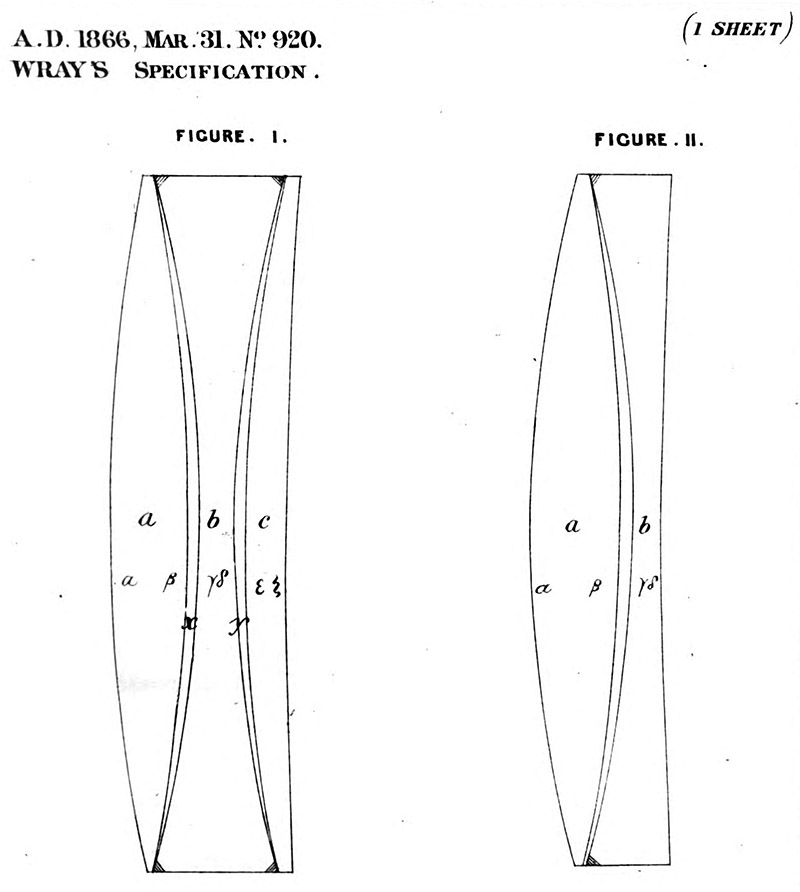
Figure 5.
Diagram from William Wray’s 1866 patent for “Improvements in achromatic object glasses”. The patent involved application of fluid or semi-fluid substances into the gaps between the ground glass lenses.
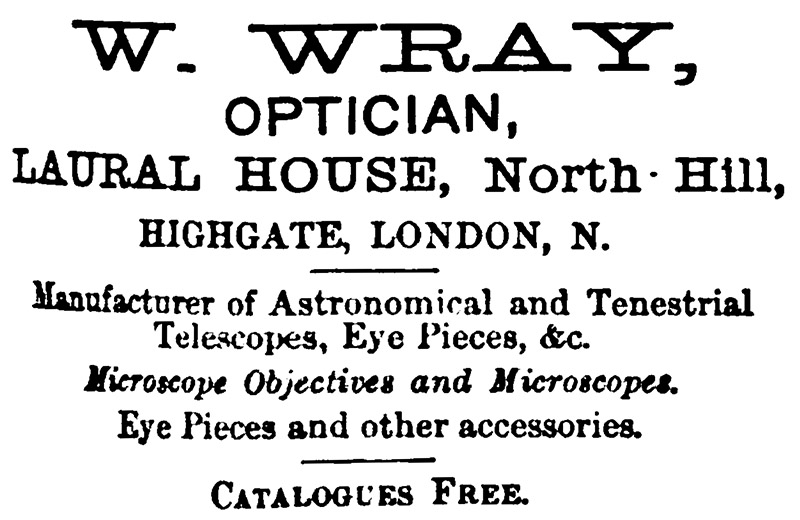
Figure 6.
An 1884 advertisement, from The Microscopical News and Northern Microscopist.
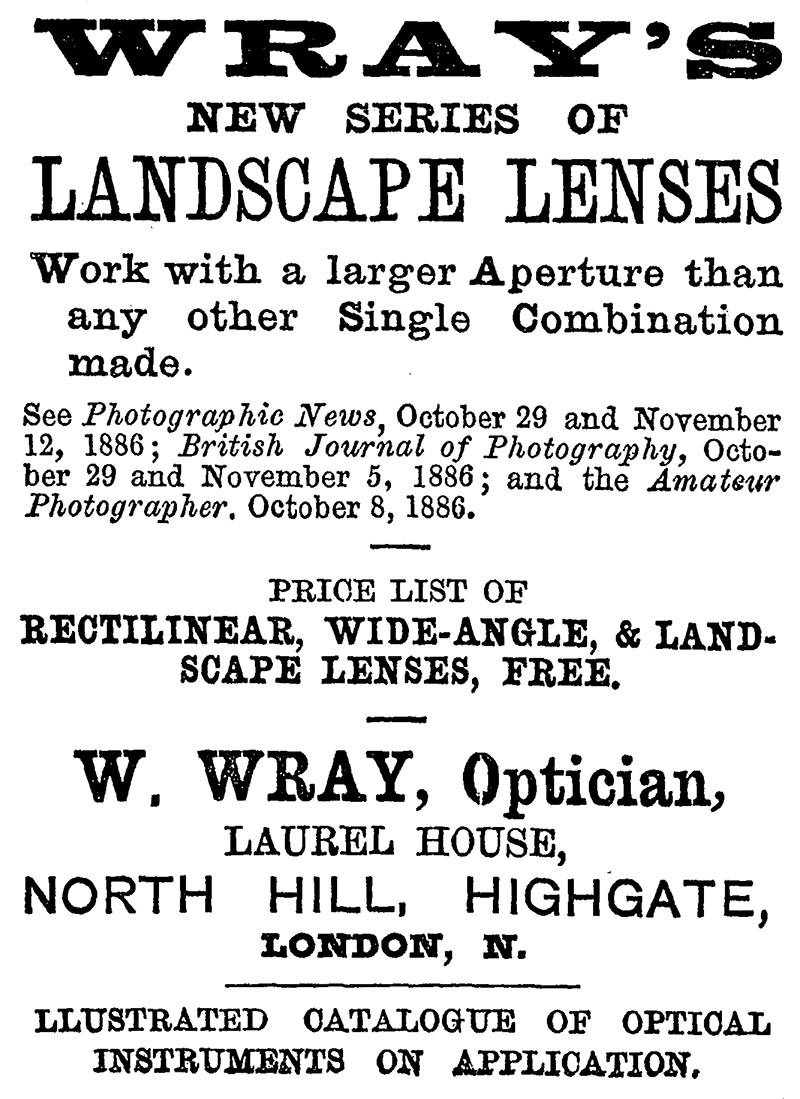
Figure 7.
An 1888 advertisement, from “The Photographic News”.
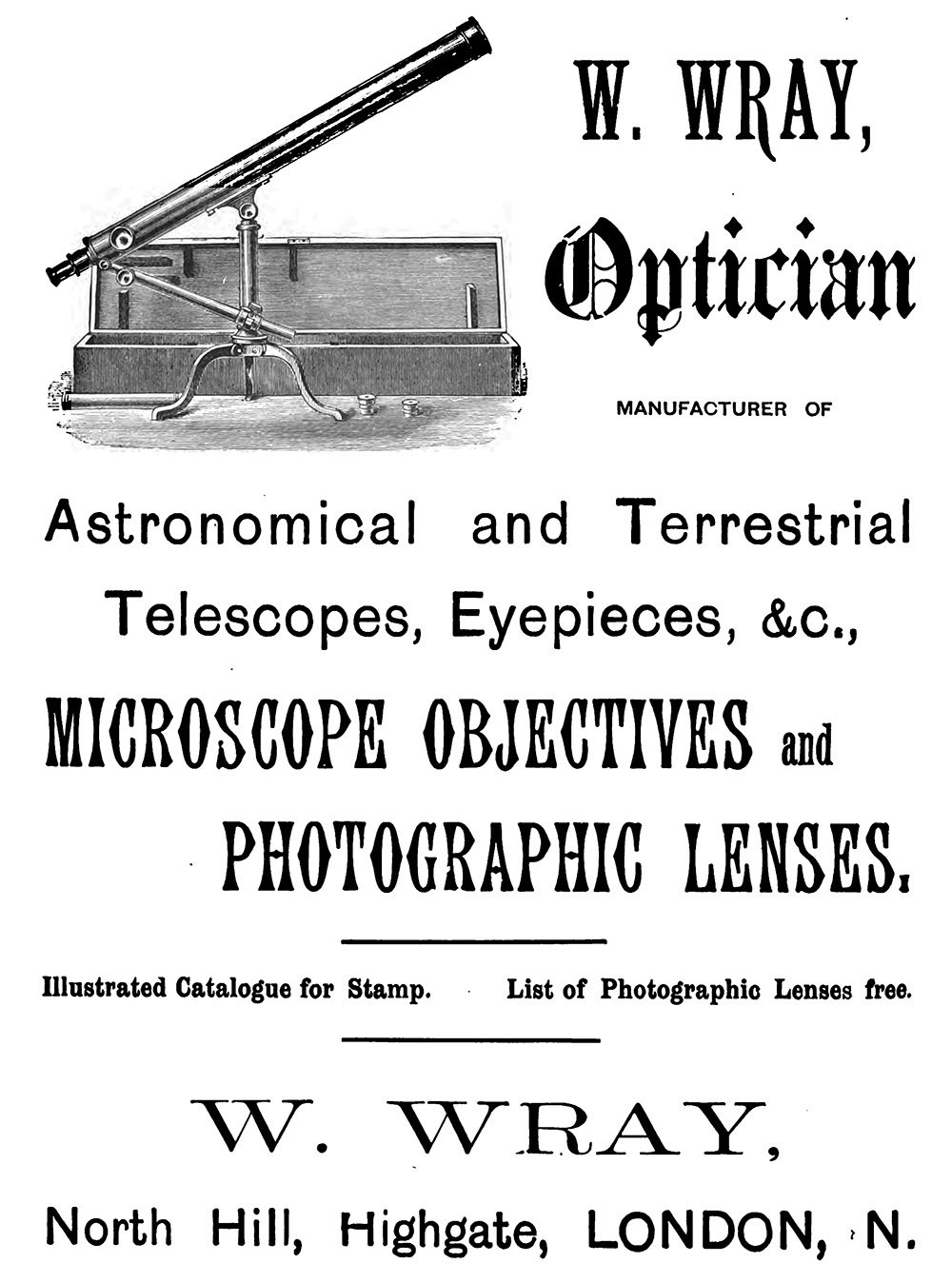
Figure 8.
An 1893 advertisement, from Arthur Mee’s “Observational Astronomy”.
Resources
Baptism record of William Wray (1830) accessed though ancestry.com
Beckett, Edmund (1883) “Mr. Wray, an optician, patented a 'semi-fluid cement of oil of cassia and castor oil, or Canada balsam, to be interposed as a meniscus lens hermetically sealed' between the crown and flint lens, the crown glass being made flatter at the back than usual, to leave room for the meniscus of cement”, Astronomy Without Mathematics, Society for Promoting Christian Knowledge, London, pages 383-384
earlyphotography.co.uk/site/companies5.html (accessed June, 2022) Wray
England census and other records, accessed though ancestry.com
English Mechanic and World of Science (1891) Advertisement from W. Wray, Vol. 53, cover of the February 27 issue
“Hyperion” (1871) On the telescope, English Mechanic and World of Science, Vol. 12, page 472
The Journal of the Quekett Microscopical Club (1894) Advertisement from W. Wray
Marriage record of William Wray and Eliza Turnbull (1850) parish records of St. Bride Fleet Street, London, accessed though ancestry.com
Mee, Arthur (1893) Advertisement from W. Wray, Observational Astronomy: A Book for Beginners, A. Mee, Cardiff, back of the book
Microscopical News and Northern Microscopist (1882) A visit to an objective factory, Vol. 2, pages 21-25
Microscopical News and Northern Microscopist (1884) Advertisements from William Wray, Vol. 4, multiple issues
Monthly Notices of the Royal Astronomical Society (1886) Obituary of William Wray, pages 121-122
Morgan, William (1883) Micro-photography, The Photographic News, Vol. 27, pages 310-311
The Photographic News (1888) Advertisements from W. Wray, multiple issues
Photography (1894) The Central, Vol. 6, page 646
Probate of the will of William Wray (1885) “Wray William Administration of the Personal Estate of William Wray late of Laurel House North-hill Highgate in the County of Middlesex Optician who died 31 December 1885 at Laurel House was granted at the Principal Registry to William James Wray of Laurel House Optician the Son and one of the Next of Kin. Personal estate £1233 17s 5d”, accessed through ancestry.com
Probate of the will of Eliza Wray (1906) “Wray Eliza of Laurel-house Highgate Middlesex widow died 21 March 1906 Probate London 3 May to William James Wray and Joseph Turnbull opticians Effects £779 5s”, accessed through ancestry.com
Probate of the will of Joseph Turnbull (1913) “Turnbull Joseph of Laurel House 59 North-hill Highgate Middlsex died 30 May 1913 at Muswell High-rise Muswell Hill Middlesex Probate London 26 June to Anne Eliza Wray spinster. Effects £513 9s 6d”, accessed through ancestry.com
Reade, J.B. (1866) On a double hemispherical condenser for the microscope, Transactions of the Royal Microscopical Society, Vol. 15, pages 3-6
Reports by the Juries (1851) Wray, page 570
Timbs, John (1853) The Yearbook of Facts in Science and Art, David Bogue, London, pages 63-64
The Weekly Reporter (1905) Wray vs. Wray, Vol. 54, pages 136-137
Wray, William (1866) Improvements in achromatic object glasses, Number 920, Specifications of Inventions, Record 1: 1617-1875, Vol. 11, Great Britain Patent Office